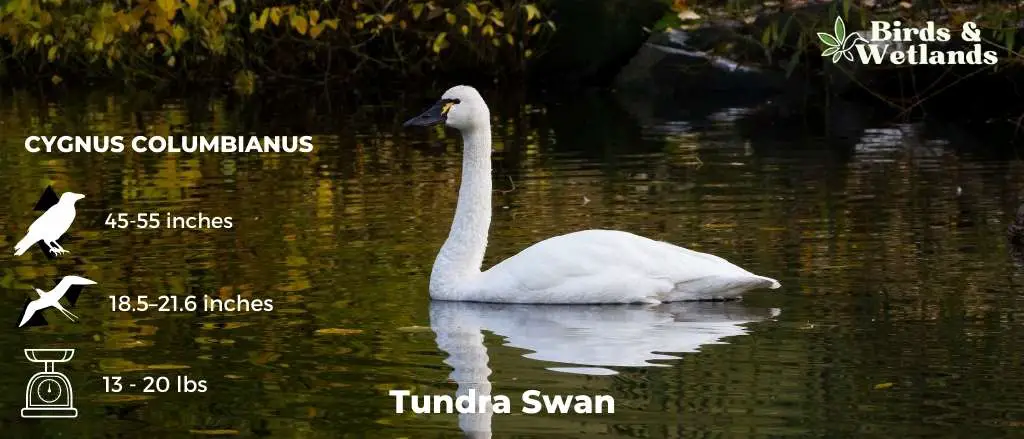The tundra swan is a compact swan breeding in North America and Eurasia’s Arctic and subarctic regions. It is known for its distinctive, high-pitched calls, audible from long distances. It is one of two native swan species of North America.
The tundra swan has two subspecies — the Bewick’s swan, named after the engraver Thomas Bewick and the whistling swan.
Tundra Swan Description
Adult whistling swans are a sight to behold. Not only are they an impressive size, but they also have stunning white plumage, a long graceful neck, dark brown eyes and a mostly black bill with an added touch of yellow just in front of their eye.
The adult female whistling swan is slightly smaller than the adult male, otherwise there are no significant differences between the two genders in terms of appearance.
The appearance of the adult Bewick’s swan is similar to the whistling swan except for the prominent yellow spot in front of the eyes. It is considered the Eurasian form of the species.
The juvenile tundra swan is characterized by its distinct appearance. It has a grayish to pale brownish head and neck and a pinkish bill tipped in black. The eye is encircled by a white ring, while the legs and webbed feet are pinkish-gray. In the second winter, it gains adult plumage.
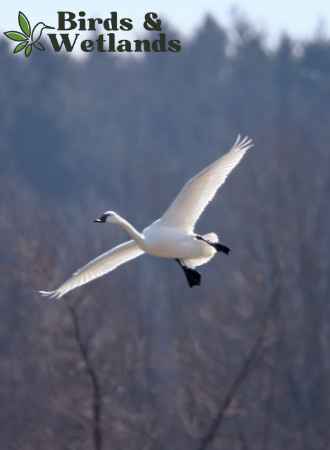
Listen to the Tundra Swan
Tundra Swan Diet
Tundra swans are omnivorous birds that primarily eat plants. In the wild, their diet includes mainly of aquatic plants such as wild celery, eelgrass, pondweed, and bulrushes. They are known to consume various other plants, including grasses, sedges, and mosses. They also eat roots, tubers, and seeds of aquatic plants.
Additionally, tundra swans will consume agricultural crops such as corn and wheat in some areas.
Tundra swans also eat a variety of animal matter to supplement their diet. They eat crayfish and other small crustaceans, aquatic and terrestrial insects such as dragonflies and beetles, small fish and their eggs and mollusks. In some areas, tundra swans eat small amphibians such as frogs and salamanders.
The diet of tundra swans can vary depending on the food availability in their habitat. They are opportunistic feeders and will consume a wide variety of food items depending on what is available to them. Their winter diet consists mostly of grains and tubers.
Tundra swans forage for food by up-ending and dabbling on the water’s surface. They also use their long necks to reach the plants growing at the bottom of the water body.
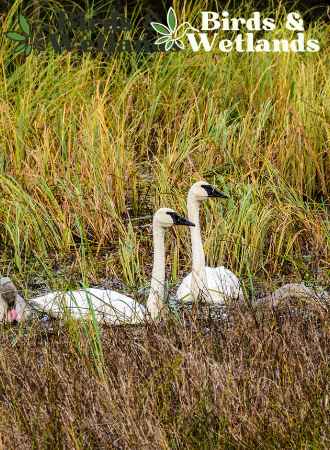
Tundra Swan Habitat
The tundra swan is a migratory bird species that prefer habitats in the arctic and subarctic tundra regions. These waterfowl breed in wetlands, shallow lakes and shorelines with shallow water depths. In some areas, they are often mistaken for the mute swan.
In autumn, large flocks of tundra swans migrate to warmer climates in search of suitable winter habitats. This usually takes place around mid-March. They prefer staging areas in nearby estuaries with brackish shorelines or wetland areas near boreal forests. These sites provide them with plenty of food sources during their journey southward.
Once the tundra swans arrive at their wintering grounds which usually takes place in mid-October, they can overwinter in many aquatic environments, including flooded fields, large lakes, coastal estuaries, ponds and rivers. They are often seen wintering with trumpeter swans.
The tundra swan is a highly adaptable species seen in almost any type of freshwater environment, whether in temperate or tropical climates.
Regarding preferred habitat preferences, tundra swans are most commonly found near open-water systems with abundant aquatic vegetation, such as marshes or shallow ponds. The presence of mudflats is also beneficial for them as it provides them access to invertebrate prey items like worms and other small critters living in these muddy substrates.
Tundra Swan Range & Distribution
The whistling swan breeds on the tundra of arctic and subarctic regions of North America and extreme northeast Siberia. The species’ breeding range encompasses vast expanses, stretching from Alaska down to as far south as Chesapeake Bay and northeastern Manitoba in Canada.
The tundra swan is one of the most widespread tundra-nesting species, often nesting up to three times higher than any other swan species.
Within its breeding range, these waterfowl can be found in both freshwater and saltwater habitats, such as wetlands and bays.
During the fall or late summer, these birds migrate south to seek warmer climates. They take shorter flights and will spend their winters along the Pacific coast in the west and Atlantic coast (eastern population) in the east of United States and Mexico, with some individuals making their way even further south into Florida or other parts of the Gulf coast region.
On the other hand, Bewick’s Swan breeds on the Kola Peninsula of the extreme northwest of Russia, which lies within arctic and subarctic regions across northern Siberia.
These swans often nest high in wetlands amongst thick grasses near lakes or ponds, allowing them to hide from predators easily.
During migration and in winter, Bewick’s Swans often venture further than its Whistling counterparts. These birds fly in family groups for thousands of kilometers yearly with more stopovers to spend winters in western Europe (including Great Britain), eastern parts of China and Korea, northern Japan and even southern parts around the Caspian Sea.
During their time in these wintering areas, they will feed along shallow bodies of water that provide invaluable sustenance during cold weather conditions.
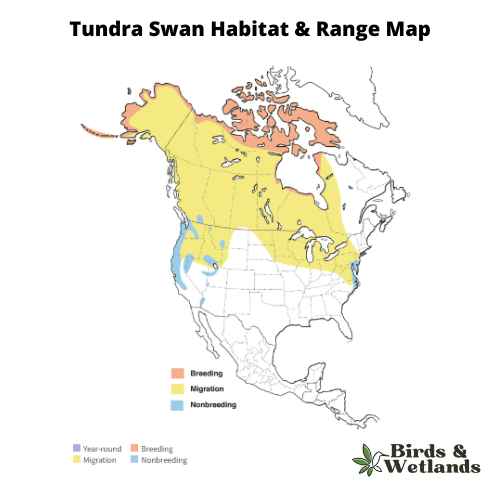
Tundra Swan Reproduction & Nesting Habits
Tundra swans typically form breeding pairs in late winter or before their spring migration. Their breeding season takes place during the late spring and summer months. During this time, they begin to search for suitable nesting sites.
Tundra swans typically nest in pairs, although they may occasionally form loose colonies. They choose nesting sites with good visibility near water, such as marshes, bogs, or other open water. The nest is a low mound constructed using plant material and is often located on small islands or in shallow water.
The female tundra swan will lay an average of 4-5 eggs per clutch, with an incubation period of around 28 to 35 days. The male and female take turns incubating the eggs, with the female spending most of the time in the nest.
Once the eggs hatch, the cygnets will leave the nest within a few days. The parents will continue to care for the cygnets, bringing them food and protecting them from predators.
The cygnets will become fully fledged at around 10-12 weeks of age, at which point they will begin to fly and learn to forage for food on their own. But they will stay with their parents, at least through their first winter.
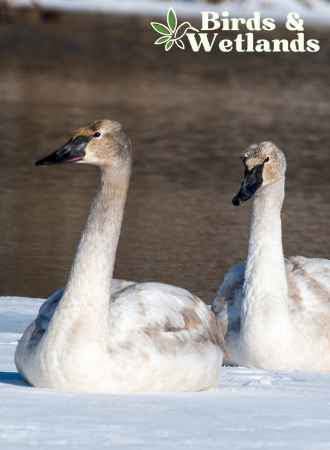
Tundra Swan Conservation Status
The current conservation status of the tundra swan is Least Concern. They are the most common swans in North America. However, due to their heavy reliance on agricultural fields in the winter, their numbers have been steadily declining over the past few years.
Additionally, pollution, habitat loss, destruction of former food sources, human settlement and predation by golden eagles and foxes also affect the survival of these birds in the wild.
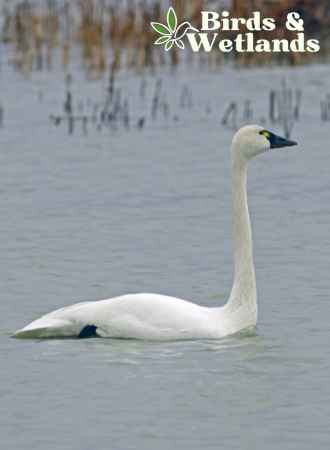
Key Takeaways
- The tundra swan is a white bird that got its common name from its preferred breeding site which spans most of the subarctic and Arctic tundra.
- The tundra swan is smaller than the trumpeter swan.
- While mute swans are year-round residents and mostly non-migratory, tundra swans spend winters in their winter habitat south of their breeding grounds.
- Males are slightly larger than females.

